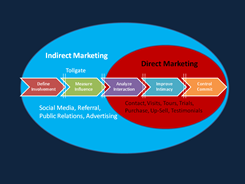What is Pull? In Lean Manufacturing the pull concept means that you are responding to the demands of the customer. You only produce per customer demands which will create a much more stable environment based on flow verses the traditional batch and queue type environment. In the service sector, the Lean Concept of pull has a similar meaning. However, it is pulling capacity or work versus material.
Dell is an example of this as they build computers to exact customer specifications. The advantage is that you meet customer’s demands quickly even though you minimize your work in process and your inventory levels. Some will argue the validity of this concept as it may just move those components to vendors’ further downstream form the customer. In the truest sense, pull should happen throughout the entire value chain.
When I discuss pull in the marketing concept people immediately relate it to the Lean concepts that I just briefly described above. As I worked through the Value Stream Marketing Concept over the past year, I started with the above diagram. I was calling the Blue Space, the Indirect Marketing concept and the Red Space, Direct Marketing. I went on to explain the concept of Indirect Marketing as a way of describing the value(achieve) that a prospect /customer would recognize by your involvement(access) within their communities(attract). These 3 levels of engagement evolved to a much simpler term of “Pull Marketing.”
These three levels of Pull have been wonderfully described in the recent book, The Power of Pull: How Small Moves, Smartly Made, Can Set Big Things in Motion. The authors defined these terms as Access, Attract and Achieve. A brief explanation condensed from the book on the three levels of Pull:
Access: The ability to fluidly find and get to the people and resources when and where we need them. It is not about “Stocks of knowledge” versus “flow of knowledge.”
Attract: Often we’re at a loss for what questions to ask, much less what to look for. Our success in finding new information and sources of inspiration increasingly depends upon serendipity – the chance encounter with someone or something that we did not even know existed, much less had value, but that proves to be extraordinarily relevant and helpful once we find out about it.
Achieve: To get better faster at whatever it is you do, you’ve got to be supported by a broad array of complementary people and resources from which you can pull what you need to raise your rate of performance improvement.
These concepts are well explained and detailed in the book with the second part of the book discussing the elements of a successful journey towards pull, they discuss; trajectory (where you are going), leverage (the ability to mobilize the passions and efforts of other people), and the best pace (the speed at which you progress). Reviewing these concepts and if you are not new to my blog, you will definitely see the similarities that I discuss of Agility, Relevance Speed and Lean. If you are trying to get a handle on marketing trends today and in the future, I believe this book is a must read: The Power of Pull: How Small Moves, Smartly Made, Can Set Big Things in Motion.


Comments are closed.